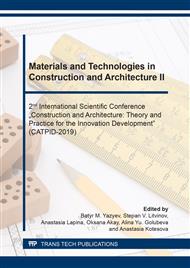[1]
A.L. Rabinovich, Introduction into the Mechanics of Reinforced Polymers, Nauka, Moscow, (1970).
Google Scholar
[2]
T. Hayachi, Photoelastsche Untersuchungen der Spannungs-Verteilung in der durch Fasern verstarkten Platte, Nonhomogenity and Plasticity, Hill. Book, New York, (1959).
Google Scholar
[3]
A.V. Turazyan, A.L. Rabinovich, On the distribution of stress in the basic model the unidirectional structures, Rep. The academy of sciences of the USSR. DAN SSSR. 194 (6) (1970) 1305–1307.
Google Scholar
[4]
B.W. Rosen, Strength of Uniaxial Fibrous Composites, In Mechanics of Composite Materials, Pergamon Press, (1970).
Google Scholar
[5]
A.S. Freydin and R.A. Turusov, Properties and Calculation of Adhesive Joints, Khimiya, Moscow, (1990).
Google Scholar
[6]
R.A. Turusov, K.T. Vuba, A.S. Frejdin, Study of the influence of temperature and humidity factors on strength and deformation properties of adhesive joints of wood with steel fittings, Scientific works of CNIISK named after V.A. Kucherenko. 24 (1972) 86-124.
Google Scholar
[7]
R.A. Turusov, A.A. Nikishin, V.G. Ivanova-Mumzhieva, Some tasks related to the determination of adhesion strength. International Symposium «polymers-73», Bulgariya, Varna. 1973, pp.198-203.
Google Scholar
[8]
R.A. Turusov, A.A. Nikishin, Y.A. Gorbatkina, Boundary layer Method in mechanics of deformable solid body. International Symposium polymers-73,, reports, Bulgaria, Varna. 1973, pp.229-233.
Google Scholar
[9]
R.A. Turusov, Z.D. Sakvarelidze, Y.M. Malinskij, Destroying mechanism research of reinforced plastics under normal and elevated temperatures. Reinforced plastics-74,, reports, Czechoslovakia, Karlovy Vary, 1974, pp.97-103.
Google Scholar
[10]
R.A. Turusov, Z.D. Sakvarelidze, Y.M. Malinskij, K.T. Vuba, Stretching composite rods, bearing in mind bending as model glue, Moscow, Strojizdat. 53 (1975) 72-80.
Google Scholar
[11]
R.A. Turusov, K.T. Vuba, Stress state and characteristics evaluation of durability of adhesive joints in shear. Physics and chemistry of materials processing, LIYAF, L-d, pp.75-84.
Google Scholar
[12]
R.A. Turusov, K.T. Vuba, Stress state and characteristics evaluation of durability of adhesive joints in normal detachment. Physics and chemistry of materials processing. 5 (1979) 87-94.
Google Scholar
[13]
R.A. Turusov, K.T. Vuba, Stress state and characteristics evaluation of durability of adhesive joints in normal detachment. Physics and chemistry of materials processing. 2 (1980) 108-115.
Google Scholar
[14]
R.A. Turusov, Elastic and temperature behavior of a leyered structure, Part I. Experiment and theory. Mechanics of Composite Materials. 50 (6) (2014) 1119-1130.
Google Scholar
[15]
R.A. Turusov, Elastic and temperature behavior of a leyered structure. Part II. Calculation results. Mechanics of Composite Materials. 51 (1) (2015) 175-183.
Google Scholar
[16]
R.A. Turusov and L.I. Manevich, Contact layer method in adhesive mechanics, Polymer Science, Series D. 3 (1) (2010) 11-19.
Google Scholar
[17]
Andreev V., Turusov R. and Tsybin N., Layered composite and contact layer, Normal separation and transversal strength. 04066. DOI: https://doi.org/10.1051/matecconf/201825104066.
DOI: 10.1051/matecconf/201825104066
Google Scholar
[18]
Z. Hashin, 1991a, Thermoelastic properties of particulate composites with imperfect interface. J. Mech. Phys. Solids 39, 745–762.
DOI: 10.1016/0022-5096(91)90023-h
Google Scholar
[19]
Z. Hashin, 1991b. The spherical inclusion with imperfect interface. J. Appl. Mech. 58, 444–449.
Google Scholar
[20]
Z Hashin, 1992. Extremum principles for elastic heterogenous media with imperfect interface and their application to bounding of effective elastic moduli. J. Mech. Phys. Solids 40, 767–781.
DOI: 10.1016/0022-5096(92)90003-k
Google Scholar
[21]
Lipton, R., Vernescu, B., Variational methods, size effects and extremal microgeometries for elastic composites with imperfect interface. Math. Models Meth. Appl. Sci. 5 (1995) 1139–1173.
DOI: 10.1142/s0218202595000607
Google Scholar
[22]
Benveniste, Y., Miloh, T., Imperfect soft and stiff interfaces in two-dimensional elasticity, Mech. Mater. 33 (2001) 309–324.
DOI: 10.1016/s0167-6636(01)00055-2
Google Scholar
[23]
John A. Nairn, Yung Ching Liu, and Costas Galiotis. Analysis of Stress Transfer from the Matrix to the Fibre Through an Imperfect Interface: Application to Raman Data and the Single-Fibre Fragmentation Test. Fibre, Matrix, and Interface Properties, ASTM STP 1290, Christopher J. Spragg and Lawrence T. Drzal, Eds., American Society for Testing and Materials, 1996, pp.47-65.
DOI: 10.1520/stp38225s
Google Scholar
[24]
Turusov R. A., Bogachev E. A. and Elakov A. B. The Role of the intensity of adhesion interaction and stiffness of the matrix in the transfer of forces from a single fibre to a broken fibre composite and in the implementation of the strength of reinforcing fibres. Part I. Mechanics of composite materials and structures. 22 (3) (2016) 430-451.
Google Scholar
[25]
Turusov R. A., Bogachev E. A. and Elakov A. B. The Role of the intensity of adhesion interaction and stiffness of the matrix in the transfer of forces from a single fibre to a broken fibre composite and in the implementation of the strength of reinforcing fibres. Part II. Mechanics of composite materials and structures. 22 (4) (2016) 536-547.
Google Scholar
[26]
Turusov R.A. Adhesion Mechanics. Moscow, MGSU, (2016).
Google Scholar


